
Found by mikeomike
wskentShe. Is. Great.
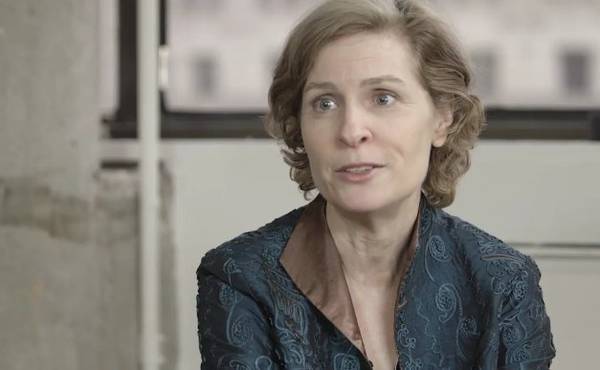
Susan Crawford (previously) is America's best commentator on network policy and network neutrality. In this interview with Ezra Klein, she makes the case for treating Internet access as a utility -- not necessarily a right, but something that markets do a bad job of supplying on their own. She describes how regulatory failures have made America into a global Internet laggard, with enormous damage to the nation's competitiveness and potential, and provides a compelling argument for locating the market for service in who gets to light up your fiber, not who gets to own it. Drawing on parallels to the national highway system and the electrification project, Crawford describes a way forward for America where the Internet is finally viewed as "an input into absolutely everything we do," and not merely as a glorified video-on-demand service.
Susan: The reason the internet is the most important development in my life is that you don't have to ask anybody for permission to start something new. You can launch something in your garage and it becomes an extraordinary thing like Facebook or Google.
What the FCC did is to try to simultaneously say, "here's some rules for the internet but we're not going to label internet access as a utility," and the DC Circuit just a month ago or so said, "You can't have it both ways. You can't both say the internet access is a luxury and have these rules about keeping this permissionless internet open."
That's why net neutrality — which is the idea that anybody can use the internet for whatever application or service they want to — is under such threat. It's because our regulator has given up its authority to say anything to the providers of high speed internet access and in that vacuum we got tremendous consolidation. Comcast is enormous company. It’s the largest media company by revenue in the world at this point. Comcast is essentially able to force Netflix to pay tribute in order to reach Netflix's subscribers.
That's possible because again our regulator has given up all oversight of these high speed internet access networks.
Ezra: If Comcast was sitting here, they would say, I think, that you began that answer by saying that the beauty of the internet is that any new company can come on to it but that, at the end of the answer, it was about Netflix, a massive incumbent who uses tremendous amounts of bandwidth. They would argue that in a limited bandwidth world, in order to keep space for the new entrants, they need to charge the incumbents taking up tremendous bandwidth. You don't think that is a reasonable response.
Susan: No, not at all actually. Right now they're charging Netflix. But Netflix got a very good price because it's so big — that’s the incumbency you mentioned. What about the next person? The next company that uses a lot of capacity could be a telemedicine service, could be distance education, they're also going to have to pay tribute to Comcast.
Comcast is making north of 95 percent profit on its provision of high-speed internet access services. Its capital expenditures as a percentage of its revenue are down to 14 percent. It's in harvesting mode. It's making tremendous amounts of money. It doesn't need to charge those companies that want to reach their subscribers, it's just can so that's what's going on.
Why the government should provide internet access ![]()
wskentHave several good musics today!

Jazz.
It’s the music that many men say they like, but don’t actually know anything about.
Which is a shame for a whole host of reasons.
For starters, jazz has had a major influence on most popular music genres in the 20th century — rock, hip-hop, Latin…the list goes on and on. Having an understanding of jazz will give a music connoisseur a deeper appreciation of whatever their favorite genre happens to be.
Second, jazz music perfectly encapsulates the American ideal of collaboration mixed with individuality, and its history is really the history of the country. Born from the music of African-American slaves, it intertwines with so many different facets of modern American life – movies, dance, art, literature, and of course, race. Thus, an understanding of jazz will provide the student of history a fascinating window into 20th century America.
Third, I think it goes unnoticed by lots of folks, but there’s definitely a masculine ethos that underlies jazz. Its emphasis on the solo and improvisation requires a performer to embrace risk, and adds an element of palatable bravado to the music. What’s more, while jazz is certainly collaborative, it’s imbued with a competitive spirit as well. Jazz musicians of the past often tried to one-up each other in virtuosity and in moving the music in brand new directions. Piano players in 1920’s New York would often muster for rousing back-and-forth “battles,” each man trotting out his best stuff during late night cutting sessions. These kinds of competitions in musical mastery continue today, even taking the popular form of the piano bar that has become so trendy in the last few years.
Finally, jazz music is simply good music. There’s a genre of jazz for every man out there. At least, I think so.
If you’ve ever wanted to get into jazz, and don’t know where to start, below we’ve laid out a beginner’s introduction to the different genres of jazz, along with a few artists and songs for each that serve as good starting places for the neophyte to dip his toes.
Hopefully this post will serve as a springboard for getting deeper into this uniquely American music, so that the next time someone asks if you like jazz, you can do more than nod!
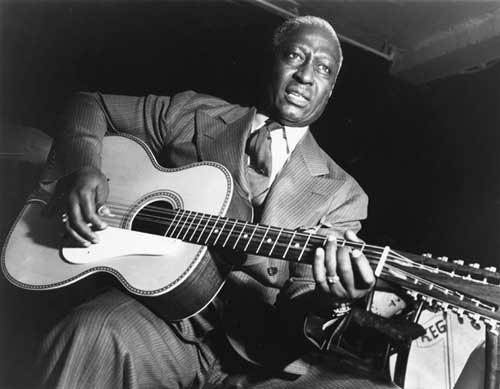
Lead Belly
Like jazz, the blues also traces its roots to 19th century Southern plantations where slaves and later, sharecroppers, would sing work songs while they toiled under the hot sun. As African-Americans learned to play European instruments, the guitar became a popular accompaniment to the soulful singing and led to the development of the blues style. The blues is characterized by a specific chord progression — often the twelve bar blues progression — as well as blue notes. A blue note is a note sung or played at a slightly lowered pitch than the major scale, which gives the note that distinctly bluesy, sad sound.
While blues developed side-by-side with jazz in the late 19th and early 20th centuries, jazz artists would incorporate many bluesy elements into jazz — particularly the twelve bar blues progression. It’s been said that when jazz gets too abstract, it always returns to the blues.
Artists You Ought to Know
W.C. Handy. Considered the Father of Blues; driving force behind the mainstreaming of blues.
Huddie “Lead Belly” Leadbetter. Wrote dozens of blues songs that have been covered countless times. Legend has it he was shot in the belly with a shotgun and survived, hence the nickname “Lead Belly.”
Bessie Smith. This singer’s style would leave a profound impact on later jazz vocalists.
Songs to Check Out
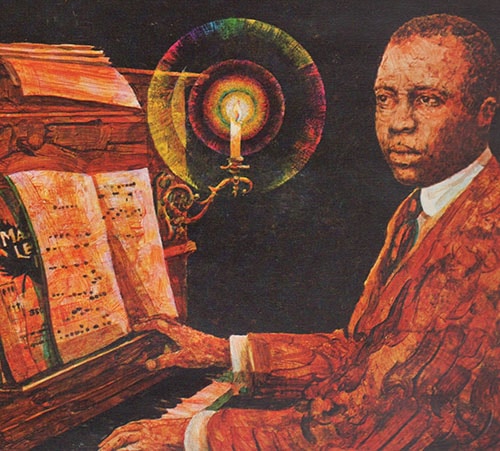
Scott Joplin
Along with the blues, ragtime was an important pre-cursor to jazz. While it could be played with other instruments, ragtime is primarily music for the piano. The defining feature of ragtime is a syncopated rhythm — accenting the notes that aren’t usually accented which gives the music an offbeat feel. The techniques used by ragtime pianists would influence later jazz pianists.
Artist You Ought to Know
Scott Joplin. “The King of Ragtime.” Composed two of the most famous pieces of ragtime music (see below).
Songs to Check Out

Jelly Roll Morton’s Red Hot Peppers
New Orleans Jazz originated with the black brass marching bands of New Orleans. Consequently, instruments like the cornet (very similar to trumpet) would become a staple in jazz. As ragtime swept the nation, these New Orleans brass bands began composing and playing more syncopated pieces. In addition to ragtime, band musicians blended in the bent notes and cords of the blues.
The invention of the Big Four beat by musician Buddy Bolden gave room for artists to improvise, and made the jazz we know today possible.
New Orleans jazz bands were typically small and consisted of a “frontline” of a cornet/trumpet, clarinet, and trombone, and then a “rhythm section” that had at least two of the following: banjo, string bass, drums, and piano. This group of instruments was the primary vehicle in New Orleans Jazz. Improvisation was collective and would be heard when a lead instrument would engage in a spontaneous counterpoint to another instrument. The jazz soloist had yet to take center stage.
The spread of New Orleans Jazz across America was quick thanks to the invention of the phonograph player. Many New Orleans Jazz musicians left New Orleans and set up shop in Chicago and New York during the Great Migration.
Artists You Ought to Know
Buddy Bolden. Sometimes called the Father of Jazz; discovered or invented the Big Four beat that made jazz possible.
Joe “King” Oliver. Cornet player and bandleader; pioneered the use of mutes (placing something like a hat over the end of the trumpet to muffle the sound a bit); mentor and teacher of Louis Armstrong.
Jelly Roll Morton. Began as a ragtime composer; the first jazz composer; loosened up the syncopated rhythm of ragtime so there was more of a “swing” in the music.
The Original Dixieland Jass Band. They weren’t actually the original — they called themselves the originals for marketing; band consisted of all white members; made the first jazz recording ever; helped popularize jazz music among white Americans.
Songs to Check Out

Louis Armstrong
Jazz bands in Chicago differentiated themselves from New Orleans bands in several ways, such as replacing the banjo with a guitar, adding a saxophone to the horn section, and changing from a 4/4 beat to a 2/4. But the most important change to come out of Chicago was the ascendency of the individual solo.
And the man who pioneered and mastered the jazz solo was Satchmo himself: Louis Armstrong.
Artist You Ought to Know
Louis Armstrong. Trumpet player; pioneered the jazz solo; had talent for melodic improvisation and an unmistakable voice. While Armstrong is closely associated with New Orleans Jazz, it was in Chicago that he made a name for himself.
Albums to Check Out
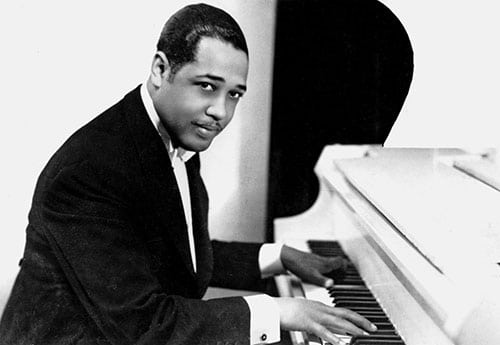
Duke Ellington
From Chicago, jazz traveled to New York where even more innovations occurred, the most important being the development of stride piano, a style which would play a prominent role in jazz from then on out. Larger bands began forming in New York City, which paved the way for the Big Band Era of the 1930s.
Artists You Ought to Know
James P. Johnson. Considered the father of stride piano. Wrote “The Charleston.”
Duke Ellington. Moved from Washington D.C. to NYC in the 1920s. Considered one of the greatest jazz composers ever and many of his songs have become American standards. Ellington and his orchestra was the house band at the famous Cotton Club in 1927.
Songs To Check Out

Benny Goodman and His Orchestra
Up until the 1930s, jazz music was enjoyed primarily by a specific sub-culture of the US population. Its associations with the seedy side of life as well as African-American culture made it unpalatable to much of mainstream white America. That changed with the rise of the Big Band Era in the 1930s. Because the Great Depression put so many regional jazz bands out of work, jazz musicians were plentiful and cheap during the 30s. Consequently, a few prominent jazz bandleaders were able to build large orchestras.
Instead of the more syncopated, “hot” style of earlier jazz, Big Bands played a looser, flowing style called swing. Swing music is primarily dance music and several new styles of dance were inspired by swing music including the Lindy Hop and the jitterbug. In addition to jazz, Big Bands also played American standards, often giving them a jazzier feel in the process.
After WWII when the economy picked up, putting together a large orchestra became much more expensive and Big Band and swing music died out.
Artists You Ought to Know
Fletcher Henderson. Credited with establishing the formula of swing music; formed one of the first Big Bands; considered (along with Duke Ellington) one of the greatest jazz arrangers ever.
Benny Goodman. Called the “King of Swing”; one of the greatest jazz clarinet players ever; first jazz musician to play Carnegie Hall; because he was white, Goodman helped popularize jazz music with white Americans; one of the first bandleaders to lead an integrated orchestra.
Count Basie. Piano player and bandleader; had a much more sparse playing style than Ellington.
Duke Ellington. Duke Ellington continued to be an influential voice all throughout the Big Band Era.
Cab Calloway. Bandleader and singer; prognosticator of jive talk and “hi di hi di hos”; wearer of zoot suits; Cab Calloway and his orchestra was one of the most popular big bands during the swing era.
Songs to Check Out
Since its beginning, jazz has always been a music catered to a popular audience. It was music to dance to or at least tap your feet to. But around the late 1940s, a shift began among jazz musicians. Instead of writing music for a popular audience, they began writing music for themselves. As Grammy nominated jazz musician Marc Cary told me, “Jazz started to get heady after the Big Band Era.”
Jazz became more and more abstract. While jazz has always been improvisational, musicians had always improvised within a set of constraints. After the Big Band Era, musicians began pushing the boundaries of what constituted jazz or even music. This desire for complete liberation from traditional musical confines was simply a reflection of changing attitudes and ideas in post-war America. Experimentation increased dramatically within jazz during the post-war years and the speed at which new styles developed increased as well.
With the above in mind, as we explore jazz from 1950 and on, note that it becomes increasingly difficult to categorize artists and even particular songs. Many jazz musicians straddled several different styles of jazz all at once and mixing genres was common.
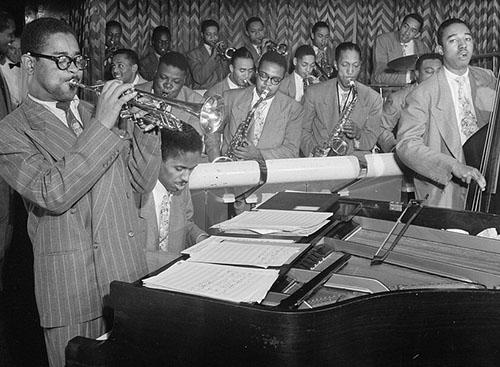
Dizzy Gillespie
The origins of bebop go back to the 1940s when young musicians playing in more traditional Big Bands would get together after shows for all-night jam sessions in which experimentation was encouraged. According to jazz historian Ted Gioia, bebop was a rebellion against “the populist trappings of swing music.” Bebop artists eschewed simple riffs for more asymmetrical ones. Solo improvisation took a more prominent role, and the tempo picked up. When you listen to bebop it sounds sort of frantic and racing. It’s nothing like the bouncy and danceable big band tunes of the prior decade.
Artists You Ought to Know
Coleman Hawkins. Tenor saxophonist; laid the foundation for the bebop era in a 1939 recording of “Body and Soul”; led a combo that included Thelonious Monk, Miles Davis, Max Roach; recorded the first bebop session in 1944.
Charlie Parker. Nicknamed “Bird”; saxophonist; he, along with trumpeter Dizzy Gillespie, became leading figures in the bebop era.
Dizzy Gillespie. Trumpet virtuoso; his puffy cheeks, bent horn, and scat singing became his trademark; infused Afro-Latin music into jazz.
Thelonious Monk. Piano player and considered one of the great jazz composers; his style was very indicative of bebop — angular and abrupt; composed several songs that are now jazz standards (“Round Midnight” and “Straight, No Chaser”).
Bud Powell. Piano virtuoso — sometimes called the “Charlie Parker of Piano”; he, along with Charlie Parker and Dizzy Gillespie, are credited with the development and maturation of bebop.
Max Roach. Drummer who helped develop the bebop style of drumming. Played with Coleman Hawkins, Dizzy Gillespie, Charlie Parker, and others.
Songs to Check Out

Miles Davis
Cool jazz was a direct response to bebop. While bebop was fast, frantic, and frenzied, cool was relaxed. Musicians downplayed the rhythm and focused on the melody and experimented by incorporating classical music elements like the whole tone scale. Cool bands would also include classical instruments in their line-up. Cool jazz is sometimes referred to as “West Coast Jazz,” though jazz aficionados would argue there’s a difference between the two.
Artists You Ought to Know
Miles Davis. Trumpet; one of the most influential musicians of the 20th century; not only lead the development of cool, but also played an integral role in the development of hard bop, modal, free, and fusion jazz. His album Birth of the Cool defines cool jazz.
Dave Brubeck. Piano player and leader of the Dave Brubeck Quintet; considered one of the great jazz pianists.
Gerry Mulligan. Saxophonist (though he played other instruments, too); played the saxophone with Miles Davis in Birth of the Cool; collaborated with Chet Baker.
Chet Baker. Trumpet player in Gerry Mulligan’s band. Became one of the defining figures of cool jazz.
Songs & Albums to Check Out
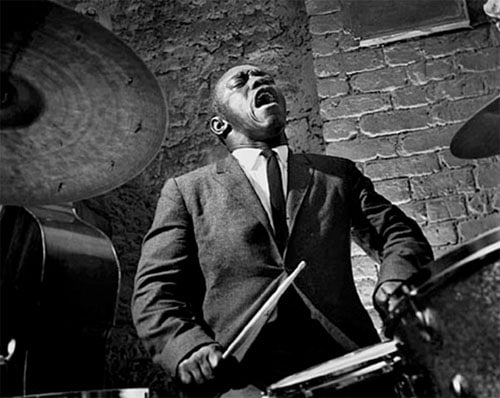
Art Blakey
Many jazz musicians felt that cool was too classical and European. Hard bop was a return to jazz that was more blues-based and Afro-centric. Hard bop musicians incorporated influences from gospel and rhythm and blues music into jazz.
Artists You Ought to Know
Miles Davis Quintet. Several influential jazz musicians played in this band during the hard bop era.
Art Blakey. Drummer who helped develop hard bop drumming; his style is still influential today.
John Coltrane. Saxophonist; member of the Miles Davis Quintet.
Sonny Rollins. Tenor saxophonist.
Horace Silver. Pianist who helped develop hard bop.
Songs to Check Out
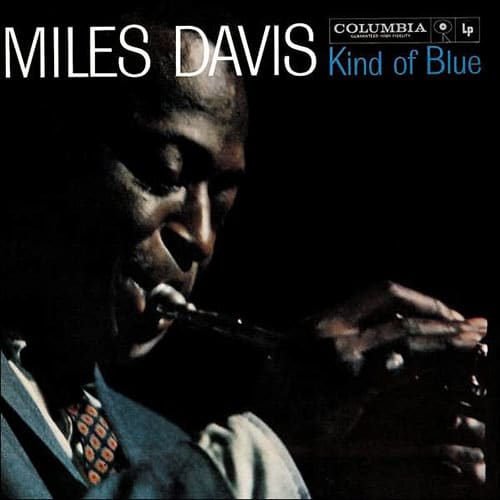
Miles Davis, Kind of Blue
Bebop and cool compositions were usually based on predetermined chord progressions. In contrast, modal jazz tunes, were based on a predetermined mode, or a certain musical scale. Also, unlike bebop or cool where changes and shifts happened quickly, in modal, the changes in modes happened very slowly. Because modal musicians only had to think about how to mix up the seven notes in a mode, they could focus more on creative improvisations.
Artists You Ought to Know
Miles Davis
John Coltrane
Songs & Albums to Check Out
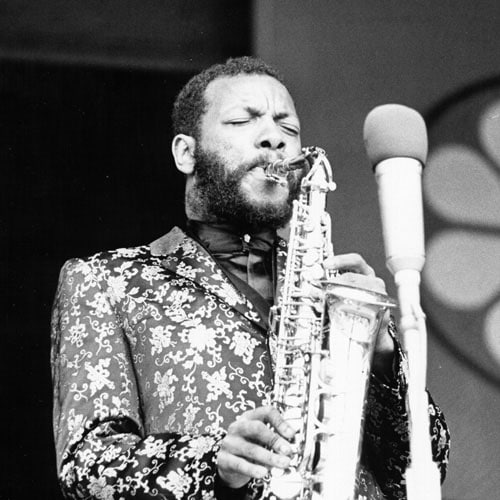
Ornette Coleman
As we’ve seen, ever since the Big Band Era, jazz musicians pushed against musical constraints. Free jazz was pretty much the elimination of any and all limitations. Instead of compositions being based on a series of predetermined chords or even modes, free jazz was simply based on sounds. Musicians would often make squeaks and squawks by over-blowing their horns. Extreme improvisations and creativity were encouraged.
In addition to eliminating predetermined chords, free jazz musicians often eliminated predetermined meters. Free jazz returned to the collective improvisation of New Orleans Jazz — the different members were constantly reacting to each other. Old became new. Free jazz captures the loosening norms in American society during the 1960s.
Artists You Ought to Know
Ornette Coleman. Played several instruments, but most known for his work on the saxophone. Often considered the father of free jazz.
Cecil Taylor. Pianist known for his highly energetic and complex improvised sounds; his piano playing style is very much percussion-like.
Charles Mingus. Bassist; defies categorization, though is often associated with the free jazz movement because he favored collective avant-garde, New Orleans-style improvisation.
John Coltrane. Coltrane’s later recordings are vey much influenced by free jazz.
Songs to Check Out
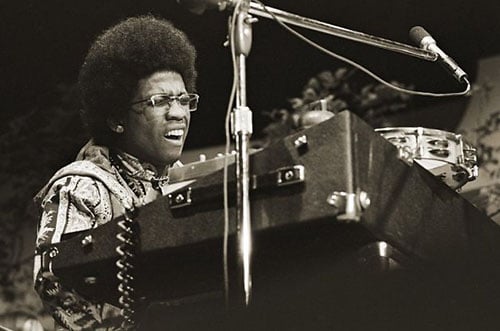
Herbie Hancock
After nearly three decades of exploring the boundaries of the avant-garde, jazz musicians in the 1970s began to bring back jazz to the mainstream with jazz fusion. Or how Cary put it, “Fusion was jazz’s last ditch effort to make jazz popular again.”
Jazz fusion is the fusion of jazz with different popular genres of music, particularly rock and funk. Jazz fusion combined the power, rhythm, and simplicity of rock ‘n roll with the sophisticated improvisation of jazz. Electronic amplification as well as other electronic musical devices from rock and funk gave jazz a different sound. While some critics and traditional jazz musicians don’t think jazz fusion is actually jazz, this style did introduce jazz to an entirely new audience.
Artists You Ought to Know
Miles Davis. What genre of jazz did Davis not help shape?
Weather Report. One of the earliest and most influential jazz fusion groups.
Herbie Hancock. Piano player who played in the Miles Davis Quintet; pioneered electronic instruments in jazz; his type of fusion typically combines funk with jazz; one of the most influential living jazz musicians today.
Chick Corea. Keyboarder; pioneered electric jazz; brings Latin jazz elements into his jazz fusion.
Freddie Hubbard. Trumpet player; fused funk with jazz.
Songs & Albums to Check Out
I hope you enjoyed this introduction to jazz and I hope this has inspired you to dig deeper into the genre.
I want to thank pianist and composer Marc Cary for his help on this post. His insights into jazz in the post-Big Band Era were extremely helpful. Check out his latest album on iTunes or Amazon.com I also want to thank friend, colleague, and jazz manager Charles Brack for his suggestions on artists I should include. Thanks to him, “Mr. Clean” is now a regular in my iTunes lineup.
If you’d like to delve deeper into the history of jazz, I highly recommend two books that I used in the research of this post:
The History of Jazz by Ted Gioia
Notes and Tones by Arthur Taylor
Other resources:
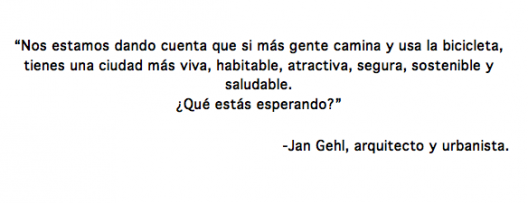
Si quieres conocer más sobre las ideas de Jan Gehl, puedes revisar los artículos “12 criterios para determinar un buen espacio público” y “¿Cómo observar el comportamiento humano en las ciudades?“.
wskentGood read. Thick and interesting. Pictures and links are good for a quick pass.
These are the prefatory remarks I made as moderator during the panel "Balancing Deep and Wide Impacts in the Design of Civic Tech" at the Digital Media and Learning Conference, Boston, MA on March 8, 2014.

I'm working on a project called Action Path. Similar to Promise Tracker, which will be the featured case study in this session, Action Path is a smartphone app for civic engagement. Specifically, the app uses geo-fencing, a technique based on the awareness of the user's GPS coordinates, to send notifications to users about opportunities to take quick actions in the form of polls or documentation of a local area for easy, yet contextually-relevant civic engagement. As indicated by my promo slide here, it's meant to marry mobile computing with the concept of a "Jane Jacobs Walk," whereby you only really understand a city's needs and resources through walking its streets. I hope you all agree that this sounds great... at least in theory.
But what does this look like in practice? Well, right now it looks like three two-hour public meetings per week, where I sit and learn about the ongoing planning processes in Somerville—the city where I live and hope to do my research. I am building trust with folks in the planning department at the City of Somerville and the leaders and organizers in civil society organizations who work on issues like land use, affordable housing, and beautification in different neighborhoods around town.
There are lot of conflicting agendas among these different groups, all of whom I need buy-in from in order to, 1) make sure that I have enough people test my app, and 2) ensure the app is stocked with relevant actions that a) make my partners feel good about endorsing it among their members, and b) make the city and private developers happy because the feedback will be in a form that can inform their planning processes, WITHOUT becoming overly politicized. I want to have real impact, and tying the technology to real impact is important for my research
In the end, I have to write this up as a thesis. And that means I need a rigorous study of some kind showing that people's understanding of their ability to make a difference in their city has changed.
I appreciate that this is an iterative and interactive process that demands flexibility, but it's also hard from the perspectives of design, research, PLUS overall impact. And it's actually the social processes around the technology that are harder to design than the mobile app itself.

At the MIT Center for Civic Media, we aspire toward co-design. Sasha Costanza-Chock, one of our affiliated faculty, has really put this at the center for his own research (see codesign.mit.edu), teaching classes that focus on the methodology and then connecting students with community members and organizations around particular themes where they work together to first define the problem through establishing a shared language, then think deeply about the context in which a potential solution would be deployed—from the politics, economics, geography, and access to resources including existing technologies. Then, they work to co-construct the solution.
The students, a.k.a. the professional designers, are there to empower the community members to design their own most appropriate solution, focusing not only on technologies but on the social processes that must surround any technological solution in order for it work effectively in context.
We don't always meet our aspirations though. We are researchers with research questions that don't automatically align with the problems and needs of a target population.
The MIT Media Lab as a whole, whose program Alexis and I are in, tends to swing to the opposite design philosophy, which has been most notably embodied by Steve Jobs, the late founder of Apple, who is famous for saying "A lot of times, people don't know what they want until you show it to them."
This is a pretty dangerous notion, but it is also oversimplified. Because there is a design philosophy in here that CAN BE highly respectful to the user, drawing on the traditions of user-centered design and human-centered design, where you really try to figure out how people use technology through observation and intuition. The goal here is to discern the simplest possible technology that works like a user would want something to work, even if they can't articulate that want verbally.
This is profoundly disempowering, of course. This creates a kind of designer-god situation, where we designers know best, and that paternalism is not good for civic technologies. And this is something we appreciate not only as designers, but also as social scientists.

Social scientific approaches such as contemporary ethnography and action research have taught us how to respect our research subjects and inform the way we now do design. Major tech firms are hiring ethnographers to understand the way technologies are actually used by people and fit within the contexts, cultures, and sub-cultures of their users.
Most relevant here is the evolution of action research from its inception in the 1940s, bringing an experimental approach to social scientific research. It argues that the attempt to produce social change is inherently a questioning of the functions of society itself and serves as an empirical method of inquiry. In many ways, action research is a design process that is iterative like all good design processes are, and contextual like good social science and design—Paulo Freire's adaptation of "participatory action research" comes to mind for how it took appreciation of context to a new level.
Still, there is always a concern over rigor when you become so close the subject you are studying and when the data are so specific: what does it mean for the research to have impact beyond an intervention?

So we see old battle lines here. But these are false dichotomies, as we now well know. The best quantitative studies are placed in the context of good qualitative work that pulls out the meaning and relevance of statistical trends. Similarly, we look to quantitative studies to extend the detailed explanations of phenomena in qualitative work to look for other spaces where society behaves similary. This is the process of creating social theory through a series of case studies. And ideally you do this to have impact.
Bent Flyvbjerg has been developing his concept of "phronetic social science" for the past decade, taking the best from action research and mixed method case studies to develop social theories tailored to real world application. He uses the Greek concept of phronesis from Aristotle's Nichomachean Ethics, which refers to a knowledge of the value of something, which requires an understanding of context but also the projection of the usefulness of research and what impact might look like to all the stakeholders including the researcher. There is a bit of experimentation here, perhaps even grounded theory, in letting things emerge through the application of different critical lenses on a given situation or phenomenon.

Furthermore, Flyvbjerg argues that it's the responsibility of the contemporary social scientist to ensure they keep impact in mind when doing the research such that when papers are published and accounts are given, they can inform an audience of politicians, designers, urban planners, activists, etc. about what worked and what didn't and how that was a function of the context, giving them the ability to iterate and do better subsequently.
I think all of us who practice social science believe that this is what we are doing, or it's what we aspire to do, but we quickly get wrapped up in the insular tendencies of our disciplines, and present incomprehensible research to each other on more than a few occasions.
One approach that is attempting to bring all of this together is "Design Action Research for Government" [pdf]. In the name, you see the pedigree of action research merged explicitly with design, and then made contextually specific to partnerships with government. Of course, this has been developed by DML's own Eric Gordon along with his research collaborator Jessica Baldwin-Philippi and the City of Boston's Chris Osgood and Nigel Jacobs, who head up the unusually progressive Office of New Urban Mechanics. Don't underestimate the importance of having a community partner with a mission of experimentation, as you will hear about in the case of Promise Tracker. But we aren't always so lucky. And even if we follow DARG's rough guidelines, there is a lot of work we designer-social scientists need to do in order to adapt any methodology to our own goals and contexts.

This brings us back to the root word at the beginning of this session's title: BALANCE. Can we strike that balance between deep and wide impact, as well as good design and good research? Can we reach our aspirations of inclusivity and diversity, including a sense of shared ownership, political sensitivity, appropriate technologies, social scientific rigor, time, and scale?
Chelsea, Heather, and Alexis will take us through their project Promise Tracker and the ways that it has evolved through its recent test deployment, showing us the way these principles and questions play out in a concrete case.
wskentEven the @ symbol has a story to tell.
wskentJust a friendly reminder for you to recall *just* how fucked up this all is.
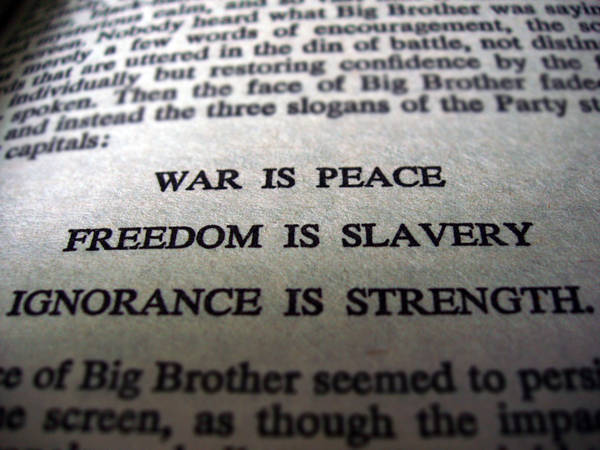
Since Netflix CEO Reid Hastings published a statement on Net Neutrality and Comcast (whom Netflix has had to bribe in order to secure normal service for its users), Comcast has gone on a charm offensive. The company sent a statement to Consumerist in which it asserts an imaginary history of championing Net Neutrality, a work of Stalin-grade reality-denying fiction that has Consumerist's Chris Morran practically chewing the keyboard in rage:
Comcast’s David Cohen, Exec. VP of Shoving Mergers Down Consumers’ Throats, actually released the following laughable statement to Consumerist and other outlets:
“There has been no company that has had a stronger commitment to openness of the Internet than Comcast. We supported the FCC’s Open Internet rules because they struck the appropriate balance between consumer protection and reasonable network management rights for ISPs. We are now the only ISP in the country that is bound by them.”
W-W-WAIT A MINUTE (Insert sound of record scratching for full effect.)
What Comcast’s Regulator Whisperer fails to mention is that Comcast is only still bound by those Open Internet rules because it’s part of the agreement Comcast made to fool the FCC and Justice Dept. into allowing its merger with NBC Universal.
This is like a paroled convict saying she’s a real homebody without revealing that she’s not allowed to leave her home except for trips to work and to visit her parole officer. Or someone who brags about having a positive impact on the environment by only using public transportation without mentioning that he had his license taken away.
It's great to have Netflix onside for Net Neutrality, now if they only weren't engaged in a war on the open Web and demanding DRM in HTML5.
Not A Joke: Comcast Says No One Is More Dedicated To Net Neutrality Than It Is [Chris Morran/Consumerist]
(Image: War is Peace? Not in my World! )![]()
wskentThis is tops.

Prolific photographer Frank Horvat captured fascinating scenes from the early 1980s in his project New York Up & Down
Via Buzzfeed
wskentOffice national du film du Canada. Faim.
The short film "Hunger" by Peter Foldès was made over 40 years ago using computers. The design is fresh. It looks like it could have been made today.
Animated film satire of self-indulgence in a hungry world. Rapidly dissolving, reshaping images, made with the aid of a computer, create a stark contrast between abundance and want. A man eats, at first sparingly, but his appetite grows to gluttony, greed, and gratification of every desire. The nightmare that finally haunts him is the one that hangs over our disparate world.
I love the soundtrack, too.
Hunger, from the National Film Board of Canada (Via Dangerous Minds)![]()
wskentThis hits the spot.

In 1990, in the middle of the moral panic over Satanic ritual abuse (an almost entirely imaginary phenomenon), Doris Sanford published "Don't Make Me Go Back, Mommy," which was "based on months of intensive research into the nature and practice of satanic ritual abuse." Sanford claimed that "Any child who has been ritually abused will recognize the validity of this story."
The story is a lurid, freakish illustrated tale ripped from tabloids and sensationalist memoirs, which was supposed to help parents, teachers and social workers help kids who'd been victims of this nonexistent epidemic.
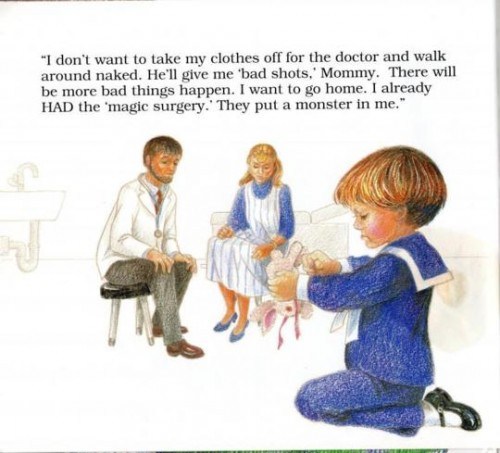

“Don’t Make Me Go Back, Mommy” : A Creepy Children’s Book About Satanic Ritual Abuse (via Christian Nightmares) ![]()
wskentHalve a slice.
As Pi Day approaches, it time for a refresher course, courtesy of Steven Strogatz, on what pi actually means and how you can visualize calculating it. It's all about rearranging the pieces of a circle in a calculus-ish sort of way:

wskentI spent maybe 10 seconds reading this.
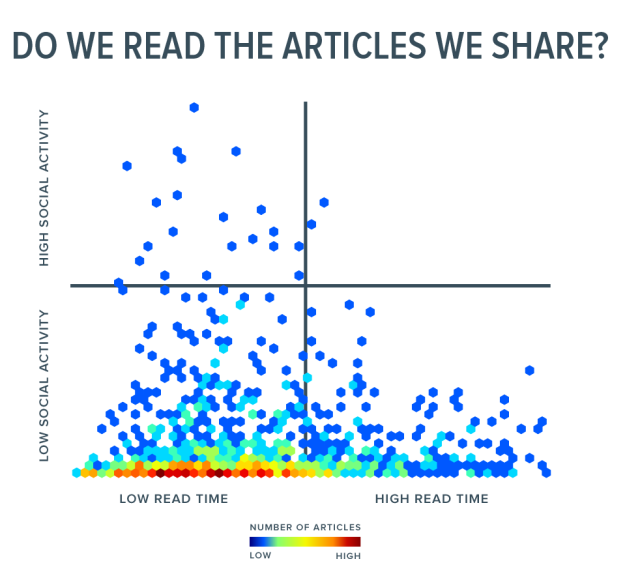
Please stare at this self-explanatory and rather sad graph for no less than 90 seconds, then share it on Facebook. Tony Haile:
If you’re an average reader, I’ve got your attention for 15 seconds, so here goes: We are getting a lot wrong about the web these days. We confuse what people have clicked on for what they’ve read. We mistake sharing for reading. We race towards new trends like native advertising without fixing what was wrong with the old ones and make the same mistakes all over again.[Time Magazine via Flowing Data]
wskentWeird. Awesome.
Today, a follow-up. Two weeks ago, I wrote an entry about "The Most Unusual Voice I've Ever Heard on an Audio Letter"
Being currently unable to accept comments to this site, I invited comments about these mysterious tapes to my own e-mail address, and was happy to hear from more than a half-dozen commenters.
Many suggested that the person speaking had undergone a tracheostomy. I was previously only familiar with the machine used by people with this impairment, which makes sort of a burping, low toned vocal sound, but I guess the sound on these recordings is an earlier method of assisting someone who has had this procedure to be able to speak.
I also got a least five suggestions as to the language being spoken. The correct answer appears to be Estonian (explained in a moment)
But one intrepid writer went much further, and by searching for the return address on the tapes, and then for the name that site turned up, found something truly amazing, and equally horrifying.
Remember that the sender of the tapes, and presumably the primary person talking, was listed as A. Mere at 180 Mere Rd. in Leicester, England. Using that information, this led my researching correspondent to a site which indicates that the person at that address, Mr. Ain Mere, was an Estonian who retired to England, and who was a collaborator with the SS during World War II. Here is the first site found.
That led both my correspondent and me to check Wikipedia, and we came up with even more information - which you can see here - that after retiring to England he was accused and convicted of war crimes, by a Russian court, and sentenced to death. As the page goes on to say, due to lack of evidence, English authorities refused to extradite him.
Several writers, intrigued by what is on these tapes, have asked where I got them. While I don't keep close records of where I've come to own most of the myriad tapes in my collection, there is really only one place I would have acquired a large collection of tapes sent from one person to another, and that is eBay. When and from where the seller was located, at this point I haven't a clue.
But this is just another reminder that you literally can never know exactly what's going to come out of the speakers on the next reel of tape you spool up. And why I'll be continuing to explore this amazing world of sound for the rest of my days.
And now, for your dining and dancing pleasure, here's another one of Ain Mere's tapes, featuring the dulcet tones of Mr. Mere. On this tape, the other person who appears on these tapes (a younger woman, I'm guessing) speaks about as much as the sender does, which is unusual for these tapes. She even briefly lapses into English a couple of times.
This tape only features two songs, but what numbers they are, first an early number by The Beatles (I think I hear him say "Beatles" in the comments just after the song ends), and the other a lovely yodeling tune - She Taught Me to Yodel - as sung by Friank Ifield, whose version was memorably lip-synched by Craig Ferguson (although my favorite version is by Rod Erickson). (The hiccup heard during the song on this tape is from a splice in the tape.)
What occurred to me, while digitizing this tape, is that there are few things that have less in common with the allegations against Ain Mere than the do either the joyful sound of the early Beatles or the good cheer found in "She Taught Me to Yodel".
Ain Mere - Greetings From England, Side One (MP3)
Ain Mere - Greetings From England, Side Two (MP3)
Tape Box Front (JPG) | Tape Box Back (JPG)
Thanks to all who wrote, and many, many thanks to GM in cyberspace for filling in the blanks!
Comments still appear to be disabled, so if you'd like to say something, please write to me at the address you can find on this page, and I'll try to add some of those comments to this post, when I get a chance.
wskentRock n roll, guys.
Google today introduced add-ons for Google Docs & Sheets and they certainly make the Google Office productivity suite more capable and more useful. If you haven’t tried them yet, open any Google document or spreadsheet in your Google Drive and look for the new add-ons menu.
For starters, add-ons in Google Docs are like extensions for Chrome. Just like Chrome extensions add new features to your browser, add-ons extend the functionality of Google Docs and Google Sheets. To give you an example, here’s the screenshot of a Twitter add-on I wrote for Google Docs and Google Sheets that you can use to find and curate tweets right inside your documents.

Twitter Curator is an add-on for Google Docs and Sheets
Anyone can write an add-on for Google Docs. All you need to have is some basic understanding of HTML, CSS (for styling the add-on) and JavaScript. The server side code is written in Google Apps Script which is similar to JavaScript but running on the Google Cloud.
Google Add-ons are also written in the Google Apps Script language but while regular Google Scripts can work on any document in your Google Drive, add-ons only work against the document or sheet that’s currently open in your browser.
Also, while Google Scripts support triggers and can run in the background (like this Website Monitor), add-ons can only run while a document or sheet is open and active.
The other big difference is that you can view the source code of regular Google Scripts while in the case of add-ons, the code is hidden from the end user. This helps developers protect their code but a downside is that the user has no clue about what’s happening behind the scenes.
We have seen issues with Chrome extensions and add-ons for Google Docs can be a target as well. For instance, an add-on can possibly email a copy of the current document or sheet to another email address? Or maybe it can share a folder in Google Drive with someone else. All add-ons currently listed in the Chrome store have been tested and reviewed by Google but if they open the gates for all, I would be a little hesitant to install add-ons created by unknown developers.
One more thing. Google Add-ons are only available for the new version of Google Sheets while Google Scripts can work on both old and new Sheets.
The Chrome store has about 50 Google add-ons at the time of launch and here are some of favorite ones that you should have in your Google Docs.
Related tutorial: How to Create a Google Docs Add-on
wskentAdd some flare.


Graphic designer Anton Burmistrov urges us to use our imaginariums. The London-based artist caught our eye with his design for the glass door of the Imaginarium, a cozy creative space “where ideas are born, where artists could come and dream about impossible things.” Drawn from the conventions and styles of 19th century lettering, his panel is a typographic reverie come true – featuring bold, elegant contrasts and a series of flourishes that would make even the most self-respecting Victorian swoon.
See Also BMD Design Serves Up Tasty Retro Typography
Although his luxurious typography communicates a dreamy beauty and almost unreal attention to detail, Burmistrov describes the very concrete labor required to create such a work:
Originally we wanted to invite an artist to beautifully handwrite this for us, just like the outstanding sign painter David A. Smith. While we ended up with my design printed on a transparent film sheet and pasted on the glass instead, it gave me the opportunity to make some details so fine that it is beyond the control of hand letterer.
Work on projects such as the Imaginarium requires lots of time, perseverance, and patience–especially in those moments when a colleague passing by will whisper, “It looks like there is the typo – did you know that there is no such word as Imaginarium?”
Despite his impressive visual skills, Burmistrov did not originally imagine himself as a full-fledged working designer. He attended art school but after realizing that graphic design was not always a career that paid the bills, Burmistrov decided to join the army. However, while on the night shift standing watch, he dreamed of creating his future portfolio and website. “Perhaps that is why I am a designer now,” Burmistrov remarks. “I couldn’t fight myself.”
See the website that Burmistrov imagined – and then immaculately realized – here.
Via: Abduzeedo
wskentIs there anything better?
Soundboart is a Beyonce soundboard. I must have pushed the AH-AH-AH button a thousand times until I discovered the SURFBOARDT button.
Tags: audio Beyoncewskent...it's happening...

Comcast's success in extracting payments from Netflix won't end its dispute with Cogent, a network operator that distributes Netflix video and other traffic, Cogent's CEO said.
Cogent operates one of several networks that Netflix uses to distribute video across the Internet. With Netflix now paying Comcast for a direct connection to that ISP's network, Cogent's role in passing traffic from Netflix to Comcast will be reduced or potentially eliminated.
But just because Netflix traffic will now flow directly from Netflix to Comcast doesn't mean that Comcast will drop its demand for payment from Cogent.
Read 23 remaining paragraphs | Comments
wskentSad and pretty. And pretty interesting.
In the 19th century, gentlemen used calling cards to formally introduce themselves to new acquaintances and to call upon friends and relatives in a dignified way.
But there was another type of card used when a gentleman wanted to get the ball rolling with a lovely lady in a more casual way: the acquaintance card. According to The Encyclopedia of Ephemera, the acquaintance card was, “A novelty variant of the American calling card of the 1870s and 1880s,” and was
“used by the less formal male in approaches to the less formal female. Given also as an ‘escort card’ or ‘invitation card,’ the device commonly carried a brief message and a simple illustration….Flirtatious and fun, the acquaintance card brought levity to what otherwise might have seemed a more formal proposal. A common means of introduction, it was never taken too seriously.”
The cards were designed as a comical way for a gentleman to break the ice, start a conversation, and flirt with the opposite sex. Sometimes the humor was overt, and sometimes it derived from the way the messages parodied the formal rules of etiquette — it wasn’t actually considered appropriate to ask for your calling card back or volunteer your escorting services so directly, as some of these cards do. Their humor and directness is kind of awesome; as an icebreaker, it seems like they’d be easier for the guy, and more enjoyable for the gal, than a lot of the awkward pick-up tap and dance of the modern day.
Flickr user Alan Mays has amassed a delightful collection of these old acquaintance cards, along with some similar novelty cards from the mid-20th century, and has allowed us to feature them here. Enjoy and hand them out to all the lucky ladies you meet today. They’re guaranteed to get you a date!*
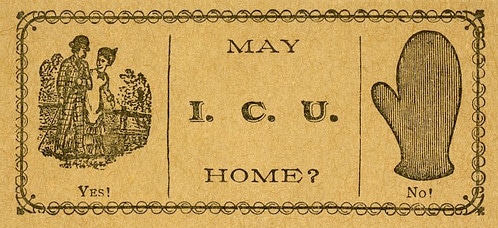
Ah, here we have the 19th century equivalent of the “Do you like me? Check yes or no” middle school love note. In old fashioned slang, “to give someone the mitten” meant to reject them or end the relationship. One wonders how the card was used…did you give it to a lady and she returned it folded to reveal her answer? Source: Alan Mays
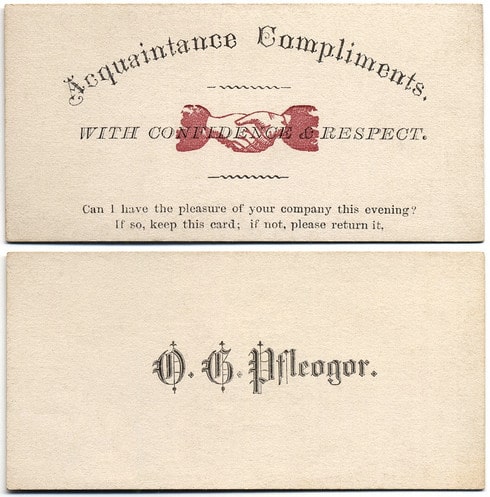
This is the only acquaintance card Mays has come across where the man’s name is printed on one side, in the manner of a calling card. Perhaps Mr. Pfleogor had a bunch made and handed them out liberally to all the ladies. Source: Alan Mays

So ladies, how do you know if a fella is flirting with you? He gives you a card that says so. Duh. Source: Alan Mays
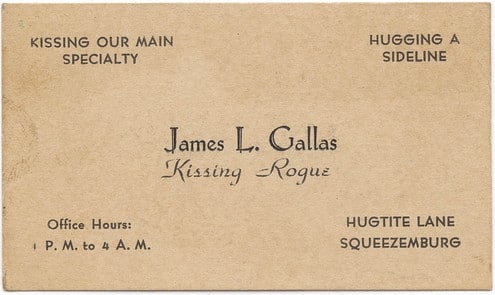
I hear the weather is wonderful in Squeezemburg this time of year. Source: Alan Mays

For the bad boy, naturally, who wishes to get right to the point. Source: Alan Mays
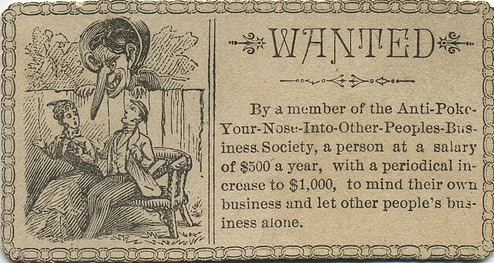
And finally, should your acquaintance card distribution win you a date, here’s a card to hand out to those who are always digging for details on your romantic conquests. Source: Alan Mays
*Guarantee valid for time machine users only. Expires February 15, 1889.
wskentMEGHAN! READ THIS. THEN VISIT BOLINAS!
Kevin Kelly is doing a Google Hangout with Lloyd Kahn today at 5pm PT.
Lloyd is one of the coolest people I know. He lives in a beautiful wooden home in Bolinas, California, that he built himself from salvaged materials. He homesteads, heating with wood he scavenges from windfalls along the road, growing organic veggies in his raised beds. He’s kept backyard chickens forever (he turned me onto backyard egg goodness). He eats roadkill. He hunts mushrooms. He makes books about homemade shelters. Runs mountain races. He visits San Francisco once a week to hear the latest music. He surfs, and skateboards. He is 79 years old!
Lloyd is a big fan of Cool Tools. He’s written a bunch of reviews for the site, and encouraged me to assemble a Cool Tools book. He worked on the original Whole Earth Catalog, where he was the “Shelter” editor, so he’s seen a lot of do-it-yourself stuff over the years. What I love about Lloyd is his enthusiasm and gumption. He is always learning new things, trying new stuff, and never letting failure stop his enjoyment. He is very young. He is also a compulsive sharer, broadcasting what he is learning for the benefit of others. I get pumped up each time I chat with him.
On Wednesday, at 5pm California time (8 EST) I hope you have a chance to see Lloyd in action. The first eight folks to sign up on this form can join us in the hangout. Anyone else can watch the conversation live stream by going to this Google Hangout link. And later there will be a recorded video on YouTube of the conversation.
We’ll talk about how Lloyd does all these cool things, how he learns so fast, what he knows about urban homesteading, his next book, and what new cool tools he recommends.
wskentGOOD TRICK!
The YouTube video player lets you easily change* the playback speed of videos. You can watch a YouTube video in slow motion and see the frames in more detail or, if the video is boring, you can switch to fast motion mode and skim through the video by doubling the playback speed.

You can play YouTube videos in slow motion or speed them up
If the option to control the playback speed is still not available in YouTube for a particular video, or if you wish to have finer control over the speed, you can always use the good old VLC Player to watch any video on YouTube (or Vimeo) in either slow motion or fast motion.
Here’s how.
Launch the VLC player and choose File -> Open Stream. Now paste the full URL of any YouTube video in the URL box and click the Open button. The video will begin to stream on your desktop inside the VLC player.
Now go to the VLC Menu bar, choose Playback and here you’ll se an option to adjust the playback speed of that video.

Unlike the YouTube player where you can only change the speed by a factor or .25x, .5x, 1.5x or 2x, VLC Player offers finer control. You can drag the slide to choose any speed between .25x to 4x of the original speed.
Related tip: Watch YouTube Playlists with VLC
wskentYeah! Who needs net neutrality! I..uhh..erm..oh.

Netflix's speed rankings show that video streaming performance on Verizon and Comcast has been dropping for the past three to four months.
The rankings were updated this morning with data from January. Verizon FiOS dropped from sixth to seventh best in the US, swapping places with Time Warner Cable. Comcast stayed in 14th place out of 17 rated providers, while Verizon DSL dropped from 16th to 17th, trading places with Clearwire.
The story is really in how each provider's megabits per second changed from month to month. Verizon FiOS suffered just a tiny drop from 2.22Mbps to 2.2Mbps from October to November, but then it went down to 2.11Mbps in December and 1.82Mbps in January.
Read 19 remaining paragraphs | Comments
wskentA world cup lurks in the wings...
For Howler Magazine, Sam Markham writes about Diego Maradona's second goal against England in the 1986 World Cup quarterfinal, aka Probably The Best Goal of All Time. Markham focuses on how a pair of radio commentators -- one English, the other from South America -- called the goal.
Morales's ecstatic commentary of Maradona's second goal is itself iconic in Argentina, and his lyrical expression "Barrilete cosmico!" (Cosmic kite!) is now shorthand in Argentina and much of South America for Maradona. His narration is a frenzied mix of poetry, yelling, and sobbing that ends with a prayer: "Thank you, God, for football, for Maradona, for these tears, for this-Argentina 2, England 0."
Even if you don't care about soccer, you should give this a listen...the dude absolutely loses his shit:
An alternate view of the spectacular goal has recently been found. Oh, and my favorite weird thing about this goal: Lionel Messi is considered by many to be Maradona's heir (both are small, Argentinian, and otherworldly talented) and in 2007, at the age of 19, he scored this goal against Getafe:
As you can see in the side-by-side comparison, it's extremely similar to Maradona's goal. Even the commentator loses it in a similar manner.
Tags: Diego Maradona Lionel Messi Sam Markham soccer sports video